Abstract
Katsuodashi, a dried bonito broth, is very basic and indispensable in Japanese cuisine and contains taste-exhibiting components and unique aroma. We previously reported that its unique aroma contributes to the preference and reinforcement effect associated with dried bonito. This study aims to elucidate the contribution of aromatic components in Katsuobushi to preference formation and reinforcement effect. Volatile components obtained from dried bonito were fractionated and the fractions were subjected to two-bottle choice test. The fractionation test suggested that the component responsible for the preference is not one but comprises multiple components. In the GC–MS analysis/reconstruction test, solution with aromatic flavor narrowed down to 125 compounds had preference, and also had reinforcement effect. Moreover, GC–MS–olfactometry analysis narrowed down the candidate components to 28 out of 125. Mice showed preference for the test solution with aromatic flavor reconstructed with 28 components but did not show reinforcement behavior.

Humans show a strong dietary preference for sugar and fat. Similarly, it has been reported that a significant preference for and a reinforcement effect of sugar and fat have been observed in rodents.Citation1,2) Sugar and fat are not the only food palatable to humans. Broth containing taste-exhibiting components (umami) that are extracted from animals or plants and unique aromatic components are also essential to enhance the deliciousness of food. In particular, katsuodashi, which is a broth extracted from flaked katsuobushi (dried bonito) using hot water, is very basic and indispensable in Japanese cuisine.
Kawasaki et al. and Ackroff et al. demonstrated that mice have preference for broth extracted from dried bonito in a two-bottle choice test.Citation3,4) Furthermore, Kawasaki et al. performed a conditioned place preference test (CPP test), which is widely used to measure reinforcement effects of rewarded samples,Citation5) and reported that dextrin solution alone did not show a significant reinforcement effect. However, dextrin solution with natural dried bonito broth (BD) showed a significant reinforcement effect.Citation6) In addition, a dashi-taste solution was prepared as a reproduction of naturally dried bonito broth after analyzing its composition of tastants, and mixed with dextrin (AD). AD alone did not induce a significant reinforcement effect, whereas AD supplemented with dried bonito flavoring agent demonstrated a significant reinforcement effect. Furthermore, olfactory-blocked mice did not show a significant reinforcement effect associated with BD. Although this suggests that olfaction plays an important role in the BD-induced reinforcement effect,Citation6) it has not yet been identified which aromatic components are preferred.
Amitsuka et al. prepared various extracts using different types of dried bonito and methods.Citation7) Obtained extracts were added to dashi-taste solutions and subjected to two-bottle choice tests. As a result, a solution containing aroma extract obtained from arabushi (a type of dried bonito) by supercritical CO2 extraction method (sCO2) was preferred. Olfactory-blocked mice did not show a significant preference for the solution containing such aroma extracts. In addition, CPP tests found the reinforcement effect of the sample solution with sCO2 as shown for dried bonito broth. These findings indicate that the sCO2 aroma contains components contributing to the preference and reinforcement effects.Citation7)
This study aims to elucidate the components contributing to the preference and reinforcement effect associated with dried bonito and to apply findings from the study in daily life in the future. We fractionated and analyzed the aromatic components of the arabushi sCO2 extract and evaluated the preference and reinforcement effect in ethological experiments.
Materials and methods
Animals
Unless otherwise noted, eight-week-old male BALB/c Cr mice were purchased from Japan SLC (Hamamatsu, Japan) and subjected to various experiments. Mice were housed in plastic cages in an animal room maintained at 23 ± 2 °C with 12/12 h light/dark cycle. Mice were given ad libitum access to water and food (MF, Oriental Yeast Co., Ltd., Tokyo, Japan) unless otherwise noted. All experiments were approved by the Kyoto University Animal Care and Use Committee in accordance with their ethical guidelines.
Fractionation of arabushi sCO2 extract
Arabushi sCO2 extract was prepared as described in the previous report.Citation7) The experimental scheme is shown in Fig. . n-Hexane (20 mL) was dissolved in sCO2 (10 g), and distilled water (20 mL) was added to the mixture. The solution was separated into hexane and water layers. The hexane layer was dehydrated with sodium sulfate and evaporated after paper filtration to obtain hexane extract (9.23 g). The hexane extract was subjected to vacuum distillation to yield 22.7 mg of volatile fraction (Fr. Hex). The Fr. Hex was subjected to silica gel column chromatography and fractionated by combination of organic solvents, n-Pentane, Diethyl ether (Et2O), and Methanol. Using a glass column packed with silica gel (WAKO GEL C100, Wako Pure Chemical Industries, Ltd., Osaka, Japan) 40 times the amount of Fr. Hex, fractionation was performed by draining 60 mL of each solvent (n-Pentane, n-Pentane with 5% Diethyl ether, Diethyl ether, Methanol) into the column in turns. Obtained solution was evaporated to yield Fr. 1 (Pentane, 4.3 mg), Fr. 2 (5% Et2O, 5.6 mg), Fr.3 (Et2O, 16.7 mg), and Fr. 4 (Methanol, 0.1 mg). All solvents were purchased from Junsei Chemical Co., Ltd. and distilled prior to use except methanol. High-performance liquid chromatography-grade methanol was directly used for the experiments.
Fig. 1. Fractionation scheme of arabushi sCO2 extract.
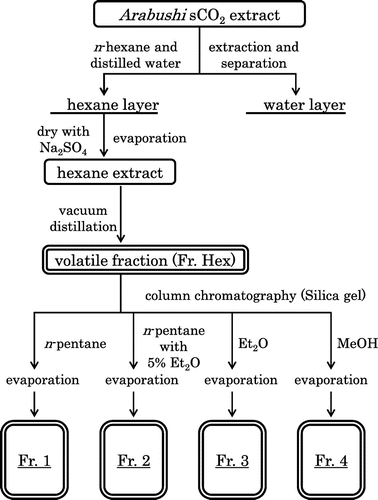
Analytical method of aromatic components of arabushi sCO2 extract hexane fraction concentration (Fr. Hex)
Aromatic components were analyzed under gas chromatography (GC)–mass spectrometry (MS) system conditions as described below. GC 6890 N (Agilent Technologies) coupled to MS5975C (Agilent Technologies); column, InertCap WAX (GL Sciences, 60 m × 0.32 mm i.d.); gas, helium; flow rate, 1.8 mL/min; injection temperature, 250 °C; oven temperature program, 40 °C initial temperature (held for 5 min), increased by 3 °C/min to 230 °C. The compounds were identified by matching Kovats index or GC retention time and mass spectrum to standards.
Narrowing down aromatic components by GC–MS–olfactometry
Of the volatile components in Fr. Hex, aromatic components that can be detected by the human nose were identified using a GC–MS–olfactometry (O) system as described below. GC 7890A (Agilent Technologies) coupled to MS5975C (Agilent Technologies), gas, nitrogen; flow rate, column, injection temperature, oven temperature program are the same conditions as arabushi sCO2 analysis described above. The column outlet was divided at the ratio of 1:1 and each branch was introduced to a flame ionization detector (FID) set at 250 °C or an olfactory detector port (ODT). Olfactory detection was performed by a well-trained flavorist of T. Hasegawa Co., Ltd.
Preparation of reconstructed aromatic flavor
GC–MS analysis of Fr. Hex identified 209 aromatic components that were detected as a peak, of which 125 components were available. Of these 125 components, the aroma of 28 components was perceived using the GC–MS–O system. Each component was formulated at the peak ratio of the GC–MS spectrum to prepare a solution of the 125 reconstructed aromatic flavors (125re), as well as solution comprising the 28 reconstructed aromatic flavors (28re) detected using GC–MS–O (Table ).
Table 1. Aromatic components of 125 reconstructed aromatic flavors (125re) and 28 reconstructed aromatic flavors (28re).
Preparation of Dashi-taste solution
The dashi-taste solution was prepared according to analytical dataCitation3) of powdered dried bonito broth obtained from Shimaya Co., Ltd. (Yamaguchi, Japan). In brief, NaCl (Nacalai Tesque, Inc., Kyoto, Japan), IMP (Tokyo Chemical Industry, Tokyo, Japan), GMP (Wako Pure Chemical industries, Ltd., Osaka, Japan), and 14 amino acids (L-Asparagine, L-Glutamic acid, L-Serine, Glycine, L-Histidine, L-Arginine, L-Threonine, L-Alanine, L-Proline, L-Tyrosine, L-Valine, L-Methionine, L-Isoleucine, and L-Leucine) were mixed similar to the reported analytical ratio of powdered dried bonito broth (powdered katsuobushi extract), and diluted with deionized water. The concentration of dashi-taste solution was equal to 1% powdered dried bonito broth solution. All amino acids were purchased from Nacalai Tesque, but L-Methionine was from Wako Pure Chemical industries.
Determination of extract and aromatic flavor addition rate
The aromatic intensity of extracts and aromatic flavors used in the two-bottle choice test and CPP test was evaluated by a well-trained flavorist of T. Hasegawa Co., Ltd. The flavorist determined the addition rate of each extract and aromatic flavor such that the aromatic intensity of the supplement samples was similar to that at the initial evaluation.
Two-bottle choice test procedure
Two-bottle choice tests were done in dark cycle. Mice were housed individually and were deprived of chow and water for 40 min before every test. All test solutions were placed in a 50 mL plastic tube fitted with a stainless steel spout. Mice were trained once a day for three days by administering deionized water and 0.89% NaCl water solutions for 30 min. After training, mice were administered dashi-taste solution and dashi-taste solution with aroma extract or aromatic flavor, and tested their preferences for the test solutions. The deprivation conditions and test time were same as in the training period otherwise noted.
Two-bottle choice test with solvent fraction of arabushi sCO2 extract
Solvent fractionation of arabushi sCO2 extract was performed and subjected to two-bottle choice test. Test solutions were prepared by adding a water layer or hexane extract separated from arabushi sCO2 to dashi-taste solution at 0.025% or 0.05%, respectively. (n = 8, each) The hexane extract was distillated to obtain Fr. Hex, which consists of volatile components. Obtained Fr. Hex was further fractionated to yield Fr. 1 to Fr. 4. Fr. Hex, Fr. 1, 2, 3, or 4 was respectively added to dashi-taste solution and the preference was evaluated using the two-bottle choice tests. (n = 8, each) The addition rate of each fraction, Fr. Hex and Fr. 1–4, was 0.025%.
Two-bottle choice test with GC–MS analysis of reconstructed aromatic flavor
An aromatic flavor, 125re (formulation of compounds detected in the sCO2 analysis), 28re (formulation of compounds narrowed down by GC–O), citral, or sCO2 was added to dashi-taste solution at 0.05, 0.05, 0.003, and 0.05%, respectively and subjected to the two-bottle choice test. (n = 8, each)
Conditioned place preference (CPP) test procedure
We used the same CPP test apparatus (Toyo Sangyo, Toyama, Japan) as previously described.Citation8) In brief, the test chamber consisted of two compartments of equal size and a small connecting zone. The wall of one compartment was black (dark box) and the other was transparent (light box). Two guillotine doors separated the connecting zone and two boxes. The experiments were conducted in the light phase. Mice were purchased when they were seven weeks old and were adequately acclimatized to handling for approximately one week of preliminary husbandry period. The CPP testing was conducted over a 10-day scheduled period. At days 1–3, mice were placed in the connecting zone and both guillotine doors were open, mice allowed to freely access between light and dark boxes without receiving any solution during a 20 min session. During the session, the time spent in each box was measured. The time spent in each box at day 3 was taken as a baseline, and individuals that did not spend time in each box for a period ranging from 200 to 500 s were excluded. The box in which the animals spent a shorter amount of time was used for conditioning test samples and the other (longer stay) for conditioning water. On days 4–9, conditioning of the test sample and water was performed. The door separating between conditioning box and connecting zone was opened and then closed immediately after the mice moved into the conditioning box. A 30-minute conditioning session was performed for either solution per day and repeated alternatively 3 times. After these conditioning sessions, mice were again allowed to freely access between both boxes without receiving any solution on day 10 for 20 min, and the time spent in each box was measured. The time spent in the box for test sample conditioning on day 10 was compared with the time on day 3. Time spent increasing rate (%) was calculated as follows; the time spent on day10 was divided by the time spent on day3 and multiplied 100. When the time spent increasing rate significantly prolonged comparing with 100%, the test sample solution was considered to have a reinforcement effect.
CPP test with reconstructed flavor
Mixed solution was prepared by adding 10% (w/v) dextrin (Matsutani Chemical Industry Co., Ltd., Hyogo, Japan) to dashi-taste solution. Mice which passed spent time screening were divided into four groups (n = 12, each). Four test solutions were created dashi-taste dextrin solution alone (non flavored) and dashi-taste dextrin solution respectively flavored with 0.05% 125re, 28re, or sCO2 (positive control) and subjected to the CPP test to investigate the presence of reinforcement effect for these test solutions.
Statistical analyses
All experiments used a criterion of p < 0.05 for statistical significance. The data were analyzed by paired t-test or one-sample t-test (CPP test). Values given in the figures are means ± SEM. All statistical analyses were performed with GraphPad Prism ver. 5. (GraphPad Software, Inc., San Diego, USA).
Results
Two-bottle choice test with solvent fraction of arabushi sCO2 extract
Solvent fractionation of arabushi sCO2 extract was performed and test solutions were prepared by adding a water layer or hexane extract to dashi-taste solution, respectively. Preference for the test solution was evaluated using the two-bottle choice tests. Consumption significantly differed for hexane extract-added dashi-taste solution, whereas no significant difference was observed for water layer-added dashi-taste solution. (Fig. (A))
Furthermore, Fr. Hex and Fr. 1–4 were subjected to two-bottle choice tests, respectively. As a result, Fr. Hex, Fr. 2, and Fr. 3 were consumed in significantly greater quantities than the control solution; however, the test solution flavored with Fr. 1 and Fr. 4 did not show a significant difference (Fig. (B)).
Upon these findings, Fr. Hex was further fractionated with various concentrations of Et2O (2, 3.5, 5, 7.5, 10, 20, and 30–100%). These fractions were respectively added to the dashi-taste solution at 0.025% and subjected to the two-bottle choice test. With the exception of 5% Et2O, all fractions had a significant preference (Supplemental Fig.).
Two-bottle choice test with GC–MS analysis of reconstructed aromatic flavor
Each aromatic flavor, 125re, 28re, citral, and sCO2 was subjected to the two-bottle choice test. As a result, although no significant increase in consumption was observed when citral alone was added, dashi-taste solution flavored with 125re, 28re, and sCO2 were consumed in significantly greater quantities than dashi-taste solution. (Fig. )
Fig. 2. Two-bottle choice test with solvent fraction of arabushi sCO2 extract.
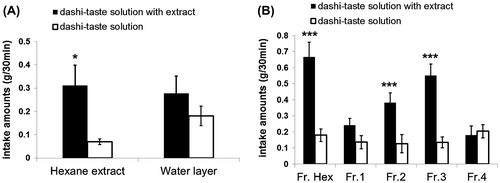
CPP test of reconstructed flavor
It was found that the dashi-taste dextrin solution alone (no aromatic supplement) and 28re-flavored solution did not significantly prolong the time spent increasing rates. (dashi-taste dextrin solution; 137.53 ± 17.18%, p > 0.05, 28re-flavored solution; 113.89 ± 9.05%, p > 0.05, means ± SEM) Hence, no reinforcement effect was observed. However, in both groups conditioned to sCO2- and 125re-flavored solution, the time spent increasing rates significantly prolonged, suggesting the presence of the reinforcement effect. (Figs. and ).
Fig. 3. Two-bottle choice test with GC–MS analysis of reconstructed aromatic flavor.
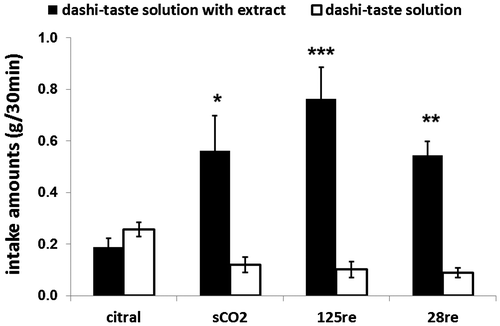
Fig. 4. CPP test flavored with arabushi sCO2 extract.
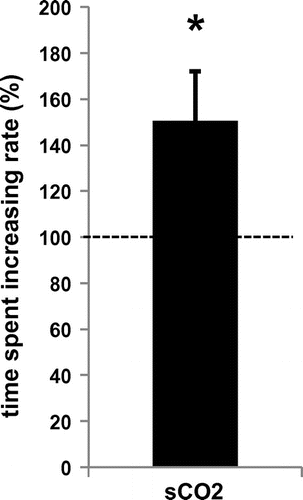
Fig. 5. CPP test flavored with 125 reconstructed aromatic flavor.
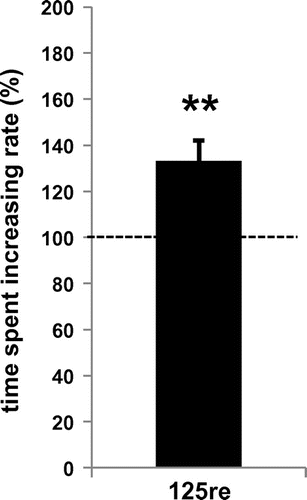
Discussion
As previously reported, the test solution with arabushi sCO2 extract evokes preference and a reinforcement effect.Citation7) We have conducted the present experiments to elucidate the compounds that are contributed to the preference and reinforcement effect. Arabushi sCO2 extract contains volatile components as well as low volatility components with a high boiling point. Amitsuka et al. conducted two-bottle choice tests with olfactory-blocked mice and reported that olfactory-blocked mice did not show preference. This suggested that the compounds responsible for the preference are contained in the volatile components; therefore, we focused on the volatile components in the sCO2 extract. We conducted two-bottle choice tests using sCO2-derived fractions that were separated and dissolved in n-hexane and in water and found that a significant preference was induced by the solution containing the hexane extract. Based on this, the lipophilic components contained in sCO2 may contribute to the preference. We collected volatile components from the lipophilic components using vacuum distillation and investigated the contribution to preference and reinforcement effect. As a result, the test solution with volatile components evoked significant preference and reinforcement effect, suggesting the compounds responsible for the preference could be contained in the volatile components.
The prolonging tendency of the time spent increasing rate was observed for dashi-taste dextrin solution but not significant. Kawasaki et al. suggested that integration of taste, olfaction, and postingestive effect evoked the reinforcement effect for dextrin solution with naturally dried bonito broth.Citation6) Since prolonging tendency did not observe for the dextrin solution alone,Citation6) faint odor derived from amino acids might contribute the prolonging tendency, but this question should be elucidated in the future.
To narrow down the compounds that play a key role in preference among the volatile components, we fractionated the volatile components using solvents with different polarities. We conducted two-bottle choice tests with dashi-taste solution containing each fraction and found a significant preference for the solution with Fr. 2 (5% Et2O) and Fr. 3 (100% Et2O). Fr. Hex was further fractionated with finely changed concentration of Et2O to narrow down the compounds more and the fractions were subjected to two-bottle choice tests. Because there were many fractions that showed preference, the compounds were only slightly narrowed down by the use of a solvent polarity. This suggested that the preference was induced by a combination of compounds rather than by a single compound.
Next, we analyzed the aromatic components of Fr. Hex, which constitute the volatile component group in sCO2 and prepared a 125 reconstructed aromatic flavor (125re) solution. When classifying the components according to functional group, phenols were the most prevalent. In the two-bottle choice test, the solution flavored with 125re was consumed significantly more.
Aromatic component has its own odor threshold.Citation9) All the 125 components do not always contribute to the aromatic character of Fr. Hex. Therefore, we used GC–MS–O system to narrow down the aromatic components. A GC–MS sniffing test of Fr. Hex was performed. GC–MS–O is the method to examine volatile components separated using GC by direct sniffing by the human nose.Citation10) With this method, useful compounds are narrowed down by evaluating separated volatile component in terms of the presence and absence of aroma, aromatic intensity, and quality. In the GC–MS–O analysis, 28 compounds were narrowed down out of 125 (Table ). The solution supplemented with 28 reconstructed aromatic flavors (28re) was also significantly consumed. The solution with citral was not significantly consumed. Therefore, increased consumption could be due to the presence of preference for 125re and 28re solution rather than a simple aromatic effect.
Oil obtained from bonito is reported to be rich in polyunsaturated fatty acids such as eicosapentaenoic acid and docosahexaenoic acidCitation11,12) and to be rapidly oxidized.Citation12) Oxidation of unsaturated fatty acid produces aliphatic aldehydes, ketones, and acidsCitation13) and amino acids form alkyl pyrazine by the Maillard reaction.Citation14) It is also known that maltol and cyclotene are produced from sugar.Citation15,16) Among the compounds contained in 28re, 1-octen-3-ol, (Z)-4-heptenal, (E)-2-nonenal, (E,Z)-2,6-nonadienal, (E,E)-2,4-decadienal, 1-octen-3-one, hexanoic acid, and octanoic acid are reportedly products of lipid oxidation.Citation13) The manufacturing processes of arabushi are as follows: (i) fresh bonito is sliced into filets and boiled; ii) the boiled bonito filets are smoked in a firewood furnace and dried. This is repeated several times; iii) the tarry parts adhering to the surface of smoked and dried bonito filets are shaved off, and the filets are shaped to complete the production of arabushi. Of phenols/pyrazines in the 28re, Ishiguro et al. reported that p-cresol, guaiacol, and 2,5-dimethylpyrazine produce aroma through the smoking and drying process.Citation17) In addition, Nishibori et al. analyzed aroma produced from dried bonito and niboshi, which is made by boiling and drying fresh anchovy. No phenolic compound was detected from the niboshi.Citation18) Smoke scent is mainly composed of phenol compounds and all phenolic compounds contained in the 125re except 3-isopropylphenol have been detected from smoke scent of dried bonito.Citation19) This suggests that phenolic compounds contained in the 28re solution may be attached during the process of smoking bonito. Similarly, vanillin, cyclotene, and maltol have also been detected from smoke scent of dried bonito.Citation19) Amitsuka et al. extracted aromatic components from various dashi materials; preference for the components was confirmed after adding them to dashi-taste solution. A significant preference was also demonstrated for the aromatic extract from niboshi; however, no phenolic compounds have been confirmed in niboshi. The trimmings from the smoked bonito during shaping (G flour) contain abundant tar components, and the solution with aromatic extract from the G flour did not induce significant preference.Citation7) Based on this, the contribution of phenolic compounds in 28re to the preference may be low, and other aromatic components derived from lipid oxidation are possibly responsible for the preference. However, further verification is required. In the CPP tests, reinforcement effect was found for test solution with 125re but not found for test solution with 28re.
Not all of the components that show preference contribute to a reinforcement effect. In addition, experiments using an opioid receptor antagonist suggest that the type of food decides mechanisms of inducing preference and acquiring reinforcement effect.Citation8,20,21) Our present study and Kawasaki et al. have also suggested that not all test solutions with aroma necessarily show preference or reinforcement effect.Citation6) Although there may be a congenital preference for aroma, a study has reported that the preference for aroma is acquired. Ayabe et al. evaluated 2-phenylethyl alcohol, which is an odorant of roses, and skatole, which is an odorant of feces, and measured preference. Children aged between 9 and 12 years of age answered that they significantly prefer 2-phenylethyl alcohol; however, two-year-old toddlers did not show a significant difference in preference. This has been explained through the associative learning of odor, the preference was acquired and posteriori based on a general value judgment on the source of the odor.Citation22) It is unknown how odor contributes to preference and reinforcement effect. Although this needs further investigation, this study suggests that the quality of odor affects preference and reinforcement effect. Difference in odor quality may affect the ease of perception during associative learning or may be associated with the palatability of food learned associatively, hedonic value, or similarity of odor remembered through previous food experience.
In summary, volatile components in sCO2 were suggested to contribute to the preference and reinforcement effect in the arabushi sCO2 fractionation test. The fractionation test also suggested that the component responsible for the preference is not one but comprises multiple components. In the GC–MS analysis/reconstruction test, the solution with aromatic flavor narrowed down to 125 compounds had preference, and also had reinforcement effect. Moreover, GC–MS–olfactometry analysis of aromatic components narrowed down the candidate components to 28 out of 125. The test solution with aromatic flavor reconstructed with 28 components had preference but no reinforcement effect. The GC–MS–O analysis of aromatic components narrowed down the candidate compounds responsible for the preference to 28.
Supplemental materials
The supplemental material for this paper is available at https://doi.org/10.1080/09168451.2017.1332975
Author contributions
Tsukasa Saito, Kazuo Inoue, and Tohru Fushiki conceived and designed the project. Maya Okamura and Kei Mukuta performed experiments and analyzed the data. Hiroko Shiibashi and Kenji Haraguchi prepared the materials. Takahiko Amitsuka analyzed the data and wrote the manuscript.
Disclosure statement
No potential conflict of interest was reported by the authors.
Supplemental_Figure.ppt
Download MS Power Point (189.5 KB)References
- Manabe Y, Matsumura S, Fushiki T. Preference for high-fat food in animals. In: Montmayeur J-P, Le Coutre J, editors. Fat detection: taste, texture, and post ingestive effects. BocaRaton: CRC Press; 2010. p. 243–264.
- Ågmo A, Galvan A, Talamantes B. Reward and reinforcement produced by drinking sucrose: two processes that may depend on different neurotransmitters. Pharmacol Biochem Behav. 1995;52(2):403–414.
- Kawasaki H, Yamada A, Fuse R, et al. Preference for dried bonito broth in olfactory-blocked or taste nerve-sectioned mice in the two-bottle choice test. Biosci Biotechnol Biochem. 2008;72(11):2840–2846.10.1271/bbb.80300
- Ackroff K, Kondoh T, Sclafani A. Dried bonito dashi: a preferred fish broth without postoral reward actions in mice. Chem Senses. 2014;39(2):159–166.10.1093/chemse/bjt065
- Tzschentke TM. Measuring reward with the conditioned place preference (CPP) paradigm: update of the last decade. Addict Biol. 2007;12(3−4):227–462.10.1111/adb.2007.12.issue-3-4
- Kawasaki H, Yamada A, Fuse R, et al. Intake of dried bonito broth flavored with dextrin solution induced conditioned place preference in mice. Biosci Biotechnol Biochem. 2011;75(12):2288–2292.10.1271/bbb.110388
- Amitsuka T, Okamura M, Shiibashi H, et al. A study of an aroma extraction method and evaluation of the aroma extract contribution to the palatability and reinforcement effect of dried bonito using mice. J Nutr Sci Vitaminol. 2014;60(5):328–333.10.3177/jnsv.60.328
- Sakamoto K, Matsumura S, Okafuji Y, et al. The opioid system contributes to the acquisition of reinforcement for dietary fat but is not required for its maintenance. Physiol Behav. 2015;138:227–235.10.1016/j.physbeh.2014.11.001
- Van Gemert L. Odour thresholds. Compilations of odour threshold values in air, water and other media. Utrecht: Oliemans Punter & Partners BV; 2003.
- Acree TE. Peer reviewed: GC/olfactometry GC with a sense of smell. Anal Chem. 1997;69(5):170A–175A.10.1021/ac971560s
- Alkio M, Gonzalez C, Jäntti M, et al. Purification of polyunsaturated fatty acid esters from tuna oil with supercritical fluid chromatography. J Am Oil Chem Soc. 2000;77(3):315–321.10.1007/s11746-000-0051-3
- Frankel E. Formation of headspace volatiles by thermal decomposition of oxidized fish oils vs. oxidized vegetable oils. J Am Oil Chem Soc. 1993;70(8):767–772.10.1007/BF02542598
- Frankel E. Volatile lipid oxidation products. Prog Lipid Res. 1983;22(1):1–33.10.1016/0163-7827(83)90002-4
- Amrani-Hemaimi M, Cerny C, Fay LB. Mechanisms of formation of alkylpyrazines in the maillard reaction. J Agric Food Chem. 1995;43(11):2818–2822.10.1021/jf00059a009
- Wnorowski A, Yaylayan VA. Influence of pyrolytic and aqueous-phase reactions on the mechanism of formation of maillard products. J Agric Food Chem. 2000;48(8):3549–3554.10.1021/jf9913099
- Yaylayan VA, Mandeville S. Stereochemical control of maltol formation in maillard reaction. J Agric Food Chem. 1994;42(3):771–775.10.1021/jf00039a034
- Ishiguro K, Wakabayashi H, Kawaguchi H. Changes in volatile compounds during smoking process and evaluation of major aroma constituents of dried bonito (katuo-bushi). J Jpn Soc Food Sci Technol. 2001;48(8):570–577.10.3136/nskkk.48.570
- Nishibori K, Okamoto K. Studies on flavor of “katsuobushi”-III. Bull Jap Soc Sci Fish. 1971;37(2):156–162.10.2331/suisan.37.156
- Maga JA. The flavor chemistry of wood smoke. Food Rev Int. 1987;3(1−2):139–183.10.1080/87559128709540810
- Sakamoto K, Okahashi T, Matsumura S, et al. The opioid system majorly contributes to preference for fat emulsions but not sucrose solutions in mice. Biosci Biotechnol Biochem. 2015;79(4):658–663.10.1080/09168451.2014.991688
- Delamater AR, Sclafani A, Bodnar RJ. Pharmacology of sucrose-reinforced place-preference conditioning. Pharmacol Biochem Behav. 2000;65(4):697–704.10.1016/S0091-3057(99)00251-8
- Ayabe-Kanamura S, Kobayakawa T, Saito S. Odor preferences Which do children: in two-year-old prefer a rose-like odor or a skatol odor? Jpn J Res Emot. 2003;10(1):25–33.10.4092/jsre.10.25
